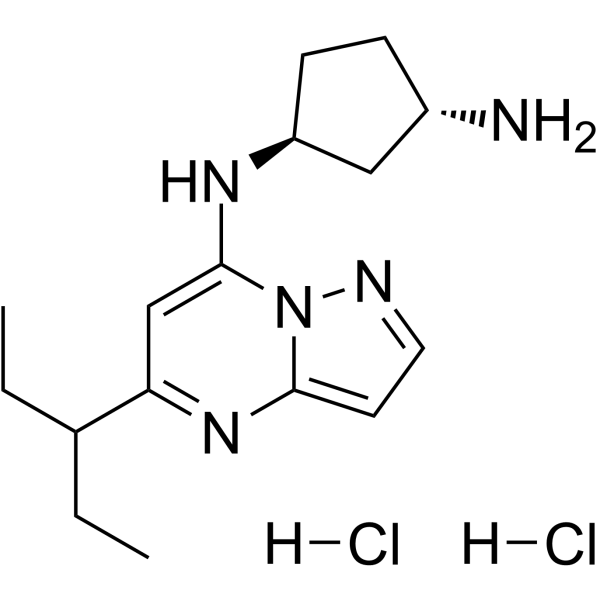Physicochemical Properties
| Molecular Formula | C16H27CL2N5 |
| Molecular Weight | 360.3251 |
| Exact Mass | 359.164 |
| Elemental Analysis | C, 53.33; H, 7.55; Cl, 19.68; N, 19.44 |
| CAS # | 2416874-75-2 |
| Related CAS # | 2416874-75-2 (HCl);2416873-83-9; |
| PubChem CID | 155819527 |
| Appearance | Light yellow to yellow solid powder |
| Hydrogen Bond Donor Count | 4 |
| Hydrogen Bond Acceptor Count | 4 |
| Rotatable Bond Count | 5 |
| Heavy Atom Count | 23 |
| Complexity | 333 |
| Defined Atom Stereocenter Count | 2 |
| SMILES | CCC(CC)C1=NC2=CC=NN2C(=C1)N[C@H]3CC[C@@H](C3)N.Cl.Cl |
| InChi Key | OTUPXOLLHVLWQF-NJHZPMQHSA-N |
| InChi Code | InChI=1S/C16H25N5.2ClH/c1-3-11(4-2)14-10-16(19-13-6-5-12(17)9-13)21-15(20-14)7-8-18-21;;/h7-8,10-13,19H,3-6,9,17H2,1-2H3;2*1H/t12-,13-;;/m0../s1 |
| Chemical Name | (1S,3S)-N1-(5-(pentan-3-yl)pyrazolo[1,5-a]pyrimidin-7-yl)cyclopentane-1,3-diamine dihydrochloride |
| Synonyms | KB-0742; KB0742; KB 0742 2HCl; KB 0742 dihydrochloride; KB 0742 hydrochloride; |
| HS Tariff Code | 2934.99.9001 |
| Storage |
Powder-20°C 3 years 4°C 2 years In solvent -80°C 6 months -20°C 1 month Note: Please store this product in a sealed and protected environment, avoid exposure to moisture. |
| Shipping Condition | Room temperature (This product is stable at ambient temperature for a few days during ordinary shipping and time spent in Customs) |
Biological Activity
| Targets | CDK9/cyclinT1 6 nM (IC50) |
| ln Vitro | RNA Pol II's downstream phosphorylation at Ser2 and Ser7 was significantly reduced, while phosphorylation at Ser5 was lowered, after 6 hours of treatment with KB-0742 (0.1–10 μM; 22Rv1 cells). Beginning around the 6-hour mark of treatment, there is a considerable reduction in the levels of the androgen receptor (AR)-FL and AR-V proteins worldwide, along with a decrease in phospho-AR (Ser81) levels[1]. Treatment with KB-0742 (48–72 hours) has cytostatic effects on leukemia and prostate cancer cell lines. With GR50s of 0.183 μM and 0.288 μM for 22Rv1 cells and MV-4-11 AML cells, respectively, KB -0742 exhibits antiproliferative activity[1]. KB-0742 quickly suppresses emerging transcription in 22Rv1 cells, specifically reducing short half-live transcripts and AR-driven cancerous programs[1]. |
| ln Vivo | In 22Rv1 human prostate cancer cell line-derived xenograft (CDX) models, KB-0742 (3-30 mg/kg; po; daily; over 21 days) dramatically reduces tumor burden while being well tolerated even at high doses[1]. |
| Cell Assay |
Western Blot Analysis[1] Cell Types: 22Rv1 cells Tested Concentrations: 0.1 μM, 0.5 μM, 1 μM, 10 μM Incubation Duration: 6 hrs (hours) Experimental Results: Significant reduction of downstream phosphorylation of RNA Pol II at Ser2 and Ser7, and diminished phosphorylation at Ser5. |
| Animal Protocol |
Animal/Disease Models: Male CB17-SCID (severe combined immunodeficient) mouse injected with 22Rv1 human prostate cancer cells[1] Doses: 3 mg/kg, 10 mg/kg, and 30 mg /kg Route of Administration: po; daily; over 21 days Experimental Results: Dramatically diminished tumor growth in castration-resistant prostate cancer (CRPC). |
| References |
[1]. Modulating Androgen Receptor-Driven Transcription in Prostate Cancer with Selective CDK9 Inhibitors. Cell Chem Biol. 2020 Oct 20;S2451-9456(20)30380-9. |
Solubility Data
| Solubility (In Vitro) |
H2O : 100 mg/mL (277.52 mM) DMSO : 62.5 mg/mL (173.45 mM) |
| Solubility (In Vivo) |
Solubility in Formulation 1: ≥ 2.08 mg/mL (5.77 mM) (saturation unknown) in 10% DMSO + 40% PEG300 + 5% Tween80 + 45% Saline (add these co-solvents sequentially from left to right, and one by one), clear solution. For example, if 1 mL of working solution is to be prepared, you can add 100 μL of 20.8 mg/mL clear DMSO stock solution to 400 μL PEG300 and mix evenly; then add 50 μL Tween-80 to the above solution and mix evenly; then add 450 μL normal saline to adjust the volume to 1 mL. Preparation of saline: Dissolve 0.9 g of sodium chloride in 100 mL ddH₂ O to obtain a clear solution. Solubility in Formulation 2: ≥ 2.08 mg/mL (5.77 mM) (saturation unknown) in 10% DMSO + 90% (20% SBE-β-CD in Saline) (add these co-solvents sequentially from left to right, and one by one), clear solution. For example, if 1 mL of working solution is to be prepared, you can add 100 μL of 20.8 mg/mL clear DMSO stock solution to 900 μL of 20% SBE-β-CD physiological saline solution and mix evenly. Preparation of 20% SBE-β-CD in Saline (4°C,1 week): Dissolve 2 g SBE-β-CD in 10 mL saline to obtain a clear solution. Solubility in Formulation 3: ≥ 2.08 mg/mL (5.77 mM) (saturation unknown) in 10% DMSO + 90% Corn Oil (add these co-solvents sequentially from left to right, and one by one), clear solution. For example, if 1 mL of working solution is to be prepared, you can add 100 μL of 20.8 mg/mL clear DMSO stock solution to 900 μL of corn oil and mix evenly. Solubility in Formulation 4: 100 mg/mL (277.52 mM) in PBS (add these co-solvents sequentially from left to right, and one by one), clear solution; with ultrasonication. (Please use freshly prepared in vivo formulations for optimal results.) |
| Preparing Stock Solutions | 1 mg | 5 mg | 10 mg | |
| 1 mM | 2.7752 mL | 13.8762 mL | 27.7523 mL | |
| 5 mM | 0.5550 mL | 2.7752 mL | 5.5505 mL | |
| 10 mM | 0.2775 mL | 1.3876 mL | 2.7752 mL |
